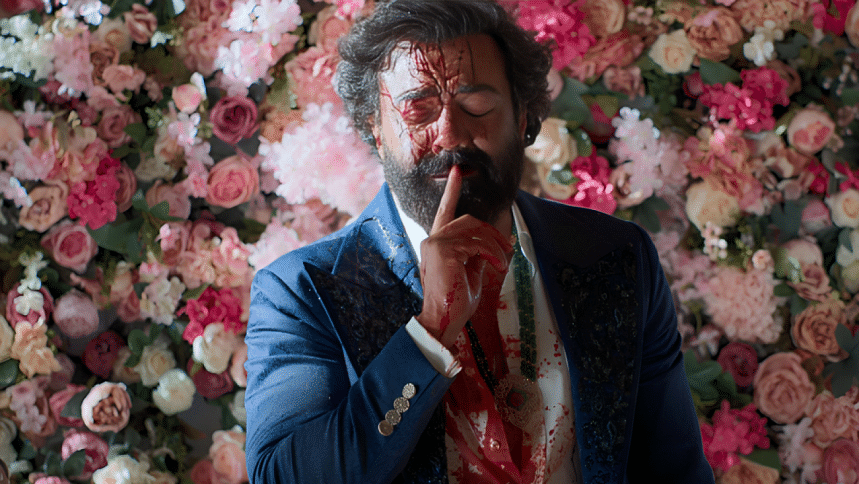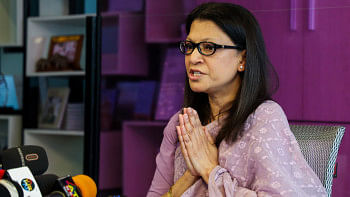‘Animal’ and the cultural politics of Muslim demonisation in Bollywood

A fair amount of feminist discourse has taken place around the movie Animal. The politics of toxic masculinity should definitely be discussed, no doubt, but one point that has been missing in this discussion is the deep politics of why—following the trends of cultural politics in Indian cinema—the villain in Animal had to be a Muslim.
Animal has grossed Rs 900 crore at the box office. As the movie was released in Bangladesh too, it's fair to assume that many of the readers have watched it. Still, a censored version of the movie was released in Bangladesh, depriving the audience of some parts of the movie relevant to this article, so allow me take some time to summarise the plot.
At the centre of the story of Animal is the character of Ranvijay Singh, played by Ranbir Kapoor. His father is the ultra-rich Balbeer Singh, who is played by Anil Kapoor. Despite being deprived of his intimacy and attention in childhood, Ranvijay's father is the centre of his world. His father's unlimited riches keep him comfortable, yet all he wants is the love of his abusive father. Even though he wants to remain a peaceful family man, Ranvijay also thinks it's fair to be as violent as necessary to protect his family members, because he thinks of himself as an "alpha male." One day, his father asks him to leave the house. Hurt, he gets married to his girlfriend and goes to the US. There, he leads a peaceful life as the father of two children. However, eight years pass and Ranvijay finds out that someone had shot his father in an attempt to kill him. He rushes back home, and vows revenge on this invisible enemy. A bloodbath follows, consuming the screen.
But who is this individual who forced Ranvijay Singh to abandon the life of a "family man" to become an "animal"? This is the film's plot; the subject of prime suspense. The second act features the emergence of a dangerous villain, who happens to be mute. Abrar, played by Bobby Deol, appears on screen to the beats of "Jamal Kudu," a Farsi song. But the story is taking place in Scotland at that point. So why the choice of Persian music? It's revealed soon after that Deol's character's full name is Abrar Haque. The music is in celebration of his third marriage. It is also revealed that it was Abrar, with his two brothers, who had plotted the murder of Balbeer Singh in order to pocket his wealth. But why? Interestingly, familial revenge is the objective here. Abrar's father is none other than the brother of Balbeer Singh, who was denied his share of the family riches by his brother. You might be wondering how someone from the "Singh" clan became a Muslim. It is worth pondering. But if we think critically, this is not the real question.
The important question here is this: why, despite being part of the same family as Kapoor's Ranvijay Singh, did Deol's character have to be "Abrar Haque"? Animal is mainly the story of revenge in the Singh family, is it not? So why couldn't the three villainous brothers (who also seek familial revenge) in this movie have been portrayed as Singhs? Of all the brothers in the Singh family, why did these three have to be portrayed as converted Haques?
Is it because showing converted Muslims as graphically evil is considered okay? Was the choice made because, regardless of the converted Muslim living in India or Scotland, it could be shown how normal it was for him to have two or three wives sitting on the wings while he got married yet again, dancing to a Farsi tune? Was it done to show how common it is for Muslims to have non-consensual intercourse with their new wives, in a scene that is shown immediately after a violent murder? Ranvijay's wife can slap him at any point, and she can decide not to have intercourse with him if she doesn't want to. But the wives of Abrar are Muslim, and Muslim women supposedly have no such thing as agency. It doesn't matter where or when, they are seemingly ready to respond to the call of their husband, or even that of their husband's brothers.
Admittedly, this anti-Muslim identity politics is the "new normal" in Indian cinema. Maybe that's why it hasn't been part of the discourse. But this problematic intersection of agency-lacking Muslim women and the anti-Muslim identity politics that was represented in this movie was missing from the feminist discourse surrounding Animal.
If this middle-class fascination with the contemporary Indian cinematic universe can be circumvented for us to think a bit critically, we will see that the biggest social problems in this universe are "Musalmans" and Pakistan. The root of every severe problem, every threat to security and peace seems to be a Muslim. I like to call this phenomenon the Indian cinematic universe's "Muslim problem."
Since 9/11, Indian cinema has played a strong role in normalising anti-Islam sentiments with repeated portrayals of Islamic terrorism. "Muslim terror" has been portrayed quite often in settings outside India. Now, they are being portrayed in domestic settings, too. The "exceptionalism of Muslim barbarism" is currently the subject of various narratives in Bollywood.
In Padmavat (2018), director Sanjay Leela Bansali waved aside historical accuracy by reducing Sultan Alauddin Khilji to one of these monsters. Another propaganda film, The Kerala Story (2023) by director Sudipto Sen, marketed the dangerous narrative of "love jihad." In Goebbelsian fashion, he turned the story of three converted Muslim women on their way to Syria into the "real" story of not 300, not 3,000, but 32,000 women. To trigger public sentiment, Sen skillfully utilised emotional imagery to show how Muslim men cultivate love jihad at home, trapping Hindu women with love and sex. As per the film, they then convert these women, marry them, and ship them off to Syria as sex slaves.
Immediately after this, we witnessed the most perverted symbolic form of the collective anti-Muslim fantasy that exists in the Bollywood psyche, in the movie Adipurush (2023). Even Ravan was shown fashioning a long beard, with kohl in his eyes, just as a Muslim is shown to look like in most Bollywood films. The most evil and monstrous character in Indian mythical history was adorned with "typical Muslim" garb and symbols. According to the writer and director, Adipurush is a modern rendition of Ramayana for the new generation. And, of course, the monstrous avatar that must be established in the imagination and subconscious of the new generation has to look like a "typical Muslim."
Animal is the boldest and most recent addition to the sequence that makes up this cultural project of Muslim monsterisation. Have we ever thought about how and why the most prominent theme for cinematic content in India—instead of being love within the multicultural sphere of India, or sexuality, or suspense—is anti-Muslim nationalism? Is there a link between this rising trend and the contemporary mainstream right-wing populist movement in India? The more we understand this link, the better we will realise that cinema is not just a medium of entertainment. It is one of the most potent weapons in the hands of populist politics.
Nazmul Arefin is a PhD researcher at Centre for Criminological Research in the University of Alberta, Canada.
(This article was originally published on 'Poroshpor'. Translated from Bangla by Azmin Azran)
Views expressed in this article are the author's own.
Follow The Daily Star Opinion on Facebook for the latest opinions, commentaries and analyses by experts and professionals. To contribute your article or letter to The Daily Star Opinion, see our guidelines for submission.

 For all latest news, follow The Daily Star's Google News channel.
For all latest news, follow The Daily Star's Google News channel. 












Comments